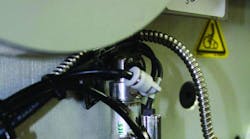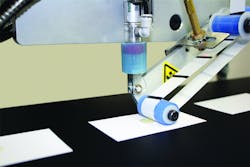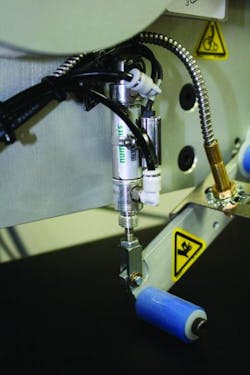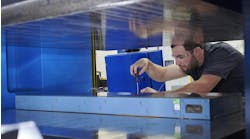Packaging-equipment manufacturers continue to push the engineering envelope to add more features to their machines and run them at higher speeds. Case in point is the recently introduced SD-900 from Glue Dots International based in New Berlin, Wis.
The SD-900 is a fully automated adhesive applicator designed to quickly and cleanly apply the company's proprietary pressure-sensitive adhesives. It's suited for general packaging applications, as well as for specialized use in the pharmaceutical, nutraceutical, cosmetic, and printing industries.
The web-fed, inline applicator incorporates a number of sensors and stepper motors that let it run at high speeds with precise, coordinated motion control. But it all comes together thanks to a pneumatic cylinder from Numatics Inc., Novi, Mich.
When in close proximity to a product, a web-fed machine, such as a label applicator, typically uses a motor to accelerate the web and apply labels onto passing products. However, Glue Dots brand adhesives require a different sequence of operations to ensure they're applied properly.
Pressure is necessary to transfer the adhesive from the web onto the passing product. Because of this, only brief contact with the product is permitted to eliminate any drag yet still facilitate transfer.
Extending and retracting the application roller onto and away from the customer's product becomes extremely important.
The Glue Dots engineers turned to a pneumatic cylinder to handle this function for the following reasons:
- Due to high product feed rates of 300 pieces per minute and product velocities of up to 90 ft/min, the extension and retraction of the applicator roller must be rapid and precise.
- Combining a cylinder with a short stroke length, mechanical stops, and a high speed pneumatic valve with fast recovery times ensured the machine met customer requirements for speed and accuracy.
- Given the high cycle rate and required loads, mechanical wear and maintenance becomes an issue. Pneumatic cylinders tend to be inexpensive and quite durable, and they can easily be replaced when components wear out. This also requires only a minimal investment by customers to stock replacements.
- Standard pneumatic components are typically stocked at distributors, resulting in short lead times.
- Pneumatic cylinders, such as the one on the SD-900, can come with internal magnets. Thus, technicians can easily mount low-cost external sensors to detect end-of-travel limits.
- Pneumatic cylinders are also available with internal bumpers or cushions to reduce vibration and mechanical stresses during cycling.
- When extended, a pneumatic cylinder can act as a shock absorber to accommodate variations in the product surface geometry, while maintaining adequate contact and pressure on the product to transfer adhesive.
- Pressure to apply adhesive patterns can easily be adjusted via a regulatIn addition, thanks to the wide use of compressed air in industrial environments, pneumatics offers a convenient and simple way to transmit mechanical forces spanning long distances, around corners, and in hard-to-reach locations.
Compressed air is a familiar and well-known technology, making the implementation and use of the SD-900 easier and more economical for customers.
The pneumatic system within the SD-900 allows it to have a feed rate up to 300 adhesive applications per minute with dot-placement accuracy of ñ0.09 in. Without the use of the pneumatic cylinder, the application process simply would not be possible.
The double-acting Numatics cylinder used on the SD-900 has a 0.56 in. diameter, bumpers at both ends, and a rear pivot mount. It's made of aluminum and stainless steel and is pressure rated to 250 psig.
Elizabeth Stock is the Sales and Marketing Coordinator at Glue Dots International, New Berlin, Wis. For more information on the SD-900, visit www.gluedots.com/SD-900. For more details on Numatics cylinders, visit www.numatics.com.




